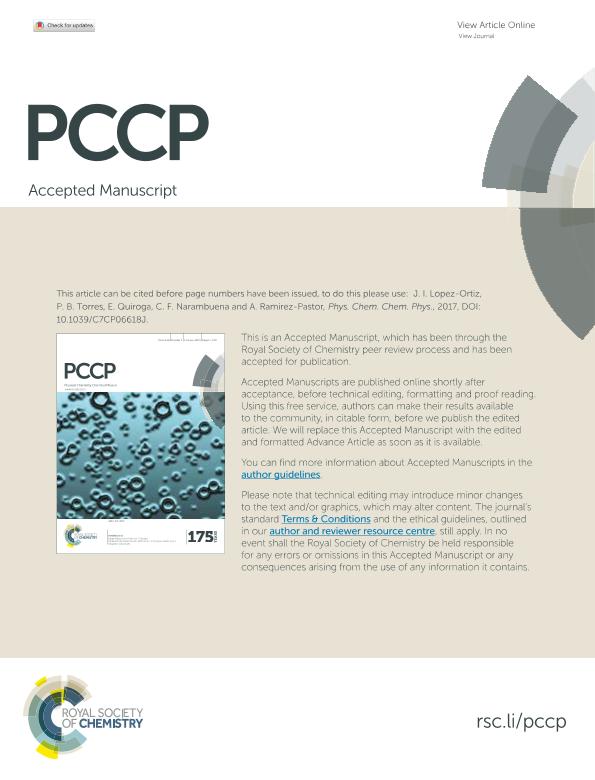Mostrar el registro sencillo del ítem
dc.contributor.author
López Ortiz, Juan Ignacio

dc.contributor.author
Torres, Paola Beatriz

dc.contributor.author
Quiroga, Evelina

dc.contributor.author
Narambuena, Claudio Fabian

dc.contributor.author
Ramirez Pastor, Antonio Jose

dc.date.available
2018-11-07T15:13:47Z
dc.date.issued
2017-11
dc.identifier.citation
López Ortiz, Juan Ignacio; Torres, Paola Beatriz; Quiroga, Evelina; Narambuena, Claudio Fabian; Ramirez Pastor, Antonio Jose; Adsorption of three-domain antifreeze proteins on ice: A study using LGMMAS theory and Monte Carlo simulations; Royal Society of Chemistry; Physical Chemistry Chemical Physics; 19; 46; 11-2017; 31377-31388
dc.identifier.issn
1463-9076
dc.identifier.uri
http://hdl.handle.net/11336/63856
dc.description.abstract
In the present work, the adsorption of three-domain antifreeze proteins on ice is studied by combining a statistical thermodynamics based theory and Monte Carlo simulations. The three-domain protein is modeled by a trimer, and the ice surface is represented by a lattice of adsorption sites. The statistical theory, obtained from the exact partition function of non-interacting trimers adsorbed in one dimension and its extension to two dimensions, includes the configuration of the molecule in the adsorbed state, and allows the existence of multiple adsorption states for the protein. We called this theory "lattice-gas model of molecules with multiple adsorption states" (LGMMAS). The main thermodynamics functions (partial and total adsorption isotherms, Helmholtz free energy and configurational entropy) are obtained by solving a non-linear system of j equations, where j is the total number of possible adsorption states of the protein. The theoretical results are contrasted with Monte Carlo simulations, and a modified Langmuir model (MLM) where the arrangement of the adsorption sites in space is immaterial. The formalism introduced here provides exact results in one-dimensional lattices, and offers a very accurate description in two dimensions (2D). In addition, the scheme is capable of predicting the proportion between coverage degrees corresponding to different conformations in the same energetic state. In contrast, the MLM does not distinguish between different adsorption states, and shows severe discrepancies with the 2D simulation results. These findings indicate that the adsorbate structure and the lattice geometry play fundamental roles in determining the statistics of multistate adsorbed molecules, and consequently, must be included in the theory.
dc.format
application/pdf
dc.language.iso
eng
dc.publisher
Royal Society of Chemistry

dc.rights
info:eu-repo/semantics/openAccess
dc.rights.uri
https://creativecommons.org/licenses/by-nc-sa/2.5/ar/
dc.subject
Protein
dc.subject
Antifreeze
dc.subject
Adsorption
dc.subject
Ice
dc.subject.classification
Física de los Materiales Condensados

dc.subject.classification
Ciencias Físicas

dc.subject.classification
CIENCIAS NATURALES Y EXACTAS

dc.title
Adsorption of three-domain antifreeze proteins on ice: A study using LGMMAS theory and Monte Carlo simulations
dc.type
info:eu-repo/semantics/article
dc.type
info:ar-repo/semantics/artículo
dc.type
info:eu-repo/semantics/publishedVersion
dc.date.updated
2018-10-23T17:30:31Z
dc.journal.volume
19
dc.journal.number
46
dc.journal.pagination
31377-31388
dc.journal.pais
Reino Unido

dc.journal.ciudad
Cambridge
dc.description.fil
Fil: López Ortiz, Juan Ignacio. Consejo Nacional de Investigaciones Científicas y Técnicas. Centro Científico Tecnológico Conicet - San Luis. Instituto de Física Aplicada "Dr. Jorge Andrés Zgrablich". Universidad Nacional de San Luis. Facultad de Ciencias Físico Matemáticas y Naturales. Instituto de Física Aplicada "Dr. Jorge Andrés Zgrablich"; Argentina
dc.description.fil
Fil: Torres, Paola Beatriz. Consejo Nacional de Investigaciones Científicas y Técnicas. Centro Científico Tecnológico Conicet - San Luis. Instituto de Física Aplicada "Dr. Jorge Andrés Zgrablich". Universidad Nacional de San Luis. Facultad de Ciencias Físico Matemáticas y Naturales. Instituto de Física Aplicada "Dr. Jorge Andrés Zgrablich"; Argentina. Universidad Tecnológica Nacional; Argentina
dc.description.fil
Fil: Quiroga, Evelina. Consejo Nacional de Investigaciones Científicas y Técnicas. Centro Científico Tecnológico Conicet - San Luis. Instituto de Física Aplicada "Dr. Jorge Andrés Zgrablich". Universidad Nacional de San Luis. Facultad de Ciencias Físico Matemáticas y Naturales. Instituto de Física Aplicada "Dr. Jorge Andrés Zgrablich"; Argentina
dc.description.fil
Fil: Narambuena, Claudio Fabian. Consejo Nacional de Investigaciones Científicas y Técnicas. Centro Científico Tecnológico Conicet - San Luis. Instituto de Física Aplicada "Dr. Jorge Andrés Zgrablich". Universidad Nacional de San Luis. Facultad de Ciencias Físico Matemáticas y Naturales. Instituto de Física Aplicada "Dr. Jorge Andrés Zgrablich"; Argentina
dc.description.fil
Fil: Ramirez Pastor, Antonio Jose. Consejo Nacional de Investigaciones Científicas y Técnicas. Centro Científico Tecnológico Conicet - San Luis. Instituto de Física Aplicada "Dr. Jorge Andrés Zgrablich". Universidad Nacional de San Luis. Facultad de Ciencias Físico Matemáticas y Naturales. Instituto de Física Aplicada "Dr. Jorge Andrés Zgrablich"; Argentina
dc.journal.title
Physical Chemistry Chemical Physics

dc.relation.alternativeid
info:eu-repo/semantics/altIdentifier/doi/https://dx.doi.org/10.1039/C7CP06618J
dc.relation.alternativeid
info:eu-repo/semantics/altIdentifier/url/https://pubs.rsc.org/en/Content/ArticleLanding/2017/CP/C7CP06618J
Archivos asociados
